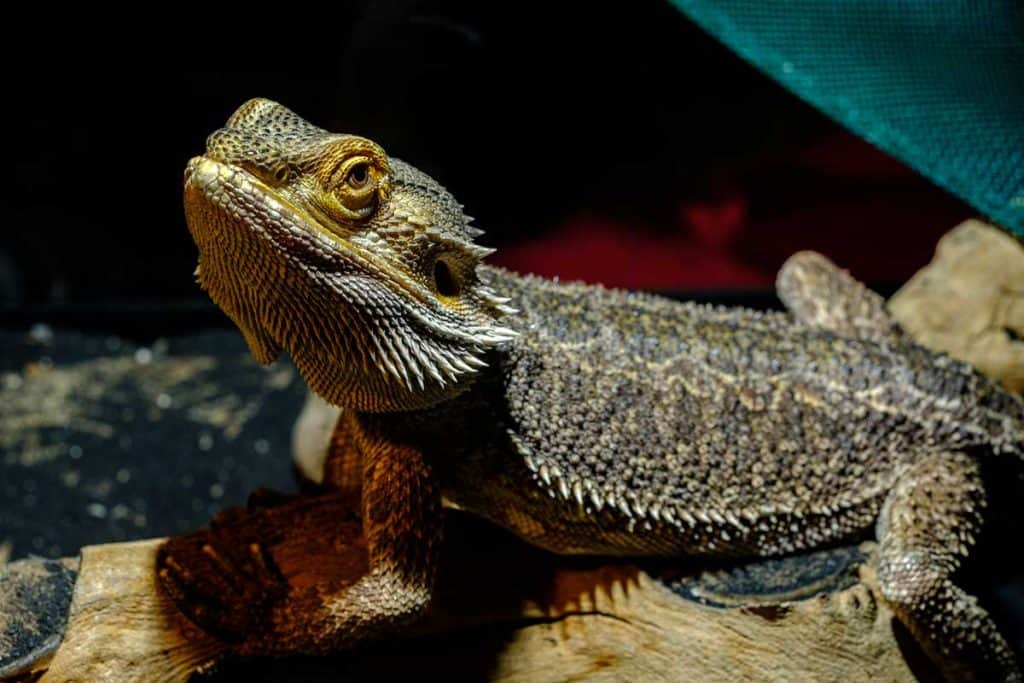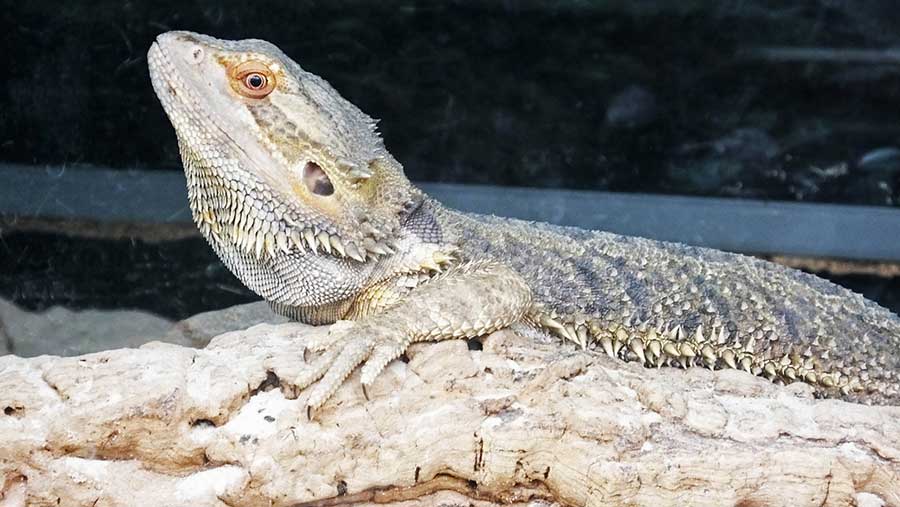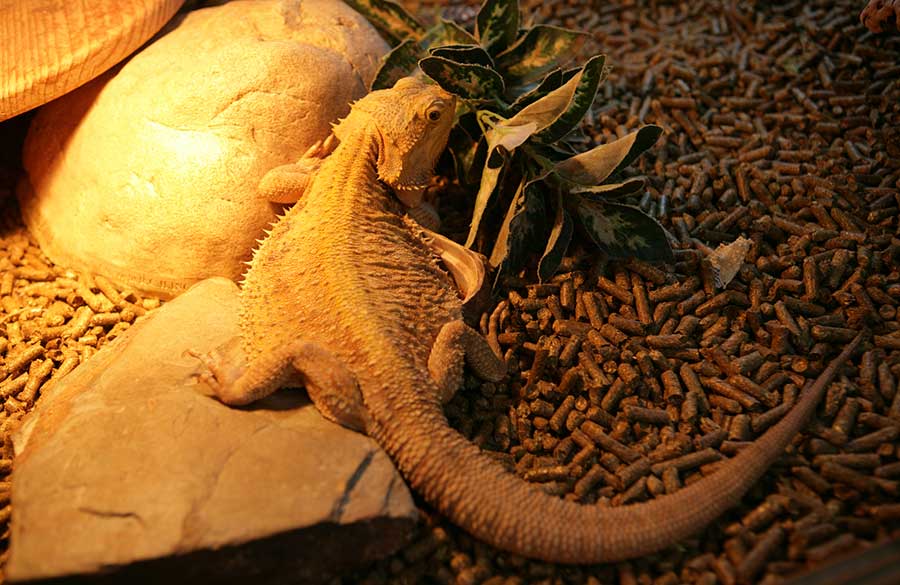Bearded dragons live most of their lives in their enclosures. Therefore, it is important that you know how to clean your bearded dragon’s tank properly and safely!
It is critical to stick to a strict cleaning schedule to keep your bearded dragon’s enclosure free of bad smells and bacterial build-up (especially salmonella).
Think about it; if you lived in a dirty environment, you would develop respiratory infections, long-term illnesses, skin issues, and have a poor mental state. Well, the same goes for bearded dragons! Beardies who are forced to live in dirty enclosures suffer both physically and mentally and will have shortened lifespans.
Read on to find out precisely what you will need to clean your beardie’s enclosure. Also included is a step-by-step guide on how to do it safely and correctly.
What You Need to Clean Your Bearded Dragon’s Enclosure
Reptiles are very sensitive to chemicals and treatments in their enclosure. Even if the chemical solution is washed out, fumes may still remain and cause chemical burns to their respiratory tract.
Using the proper tools and solutions will help preserve the lifespan of the enclosure itself as well as keep your bearded dragon happy and healthy.
Tools
It is always best to have a designated set of tools that you use for your bearded dragon’s enclosure and nothing else. There is always the chance of cross-contamination, either from the enclosure to you or from your household cleaning to your beardie.
This is a list of suggested tools to use for cleaning your bearded dragon’s enclosure:
- Paper towels
- Microfiber cloths
- A bucket
- A scraper of some kind that will not scratch glass
- A steam cleaner (not essential but excellent to have)
Paper towels are great to use because they can be thrown away. Microfiber cloths are much better to use than other cleaning cloths because they can get into crevices a lot better, and they do not leave residue behind.
Always remember to wash any cloths separately from your normal laundry and to do so with hot water and a pet-friendly detergent. Your other tools such as the bucket and scraper should also be washed away from any food prep area to avoid cross-contamination.
Cleaning Solutions
The solution or cleaning liquid you use is mostly up to personal preference. You’ll use the cleaning solution to clean your beardie’s water and food bowls daily and to deep clean the entire enclosure once a month.
This is a list of cleaning solutions that are all suitable for cleaning your bearded dragon’s enclosure.
- A specified cleaning solution for reptile enclosures like these ones from Flukers or Carolina Custom Cages.
- Dawn dish soap or any other mild dish soap that has no fragrances or harsh chemicals.
- A 1:2 mixture of vinegar to water. All items washed with this must be rinsed thoroughly afterward if the smell lingers.
- A 1:20 mixture of bleach to water. If not mixed properly or rinsed off correctly, you can kill your bearded dragon and cause yourself injury. The fumes from this mixture are toxic and should be treated carefully. This solution should only be used if the enclosure is seriously dirty or has bacterial colonies living in it.
What Not to Use
Sponges are very difficult to disinfect properly after use. They harbor bacteria and fungi in them that can be easily reintroduced to your bearded dragon’s enclosure or even into your own home! It is best to avoid using sponges to clean your bearded dragon’s enclosure unless you are diligent about throwing them away after a single use.
Using a knife or metal object to scrape the floor or walls of the enclosure is not the best option, either. Metal will cause micro-scratches on the glass or plexiglass’s surface, which are optimal breeding grounds for bacteria. These scratches are almost impossible to clean properly and pose a serious health risk to your bearded dragon.
Any soap or detergent that has any scents added to it poses a risk to your bearded dragon’s respiratory system. Beardies can be allergic to scented items just like humans can. Artificial additives can also cause skin irritation.
How Often to Clean Your Bearded Dragon’s Tank
For starters, you will need to do a “spot clean” every day. This consists of giving your bearded dragon’s enclosure a “once-over” either in the morning or evening and removing old food, picking up any poops, and replacing the water.
Additionally, once a month, you will need to do a deep clean. A deep clean means everything in the enclosure–bowls, hides, all surfaces, and so on–will need to be thoroughly cleaned to maintain the long-term cleanliness and health of your beardie.
Daily Spot Cleaning
Every day, your bearded dragon’s enclosure will need to be spot cleaned. You can do this in the morning or the evening. I always prefer to do it in the morning when I give my beardie their breakfast and daily salad.
Follow these steps to spot clean your beardie’s enclosure:
- Look for any poops and clean them up with some paper towels.
- Look for any insects that may have been left behind the previous day and fish them out. If they have pooped anywhere that you can see, clean these out, too.
- Remove your beardie’s water and food dishes and give them a good scrub with warm water and dish soap. Rinse them thoroughly before refreshing and returning them.
Monthly Deep Cleaning
Monthly deep cleaning is more intensive than routine spot cleaning. If you notice your bearded dragon’s enclosure becoming smelly, then you will need to do a deep clean every two weeks or sometimes every week depending on why your beardie’s enclosure is not staying clean.
Some dragons, particularly younger beardies, can be more active and messy than others, which means their enclosures usually require more frequent deep cleans.
Here’s how to clean your bearded dragon’s tank monthly:
- Remove your bearded dragon from the enclosure. You do not want them around any of the cleaning that is about to happen. Place them in a small, secure temporary enclosure while you clean.
- Remove all food items and water dishes and clean them with the solution you have chosen.
- Remove the accessories in the enclosure. Rocks and other stone items need to be boiled to kill all bacteria and spores. Wooden items need to be soaked in the solution and then baked to kill all microorganisms. Any plastic toys or other items should be washed in the cleaning solution.
- Remove the substrate. Paper towels should be thrown away and completely replaced weekly, loose substrate should be sterilized by baking it, and reptile carpet should be washed with hot water and your chosen solution.
- Now that the enclosure is empty, clean the inside and outside walls and floor using your chosen solution. If there is anything stuck to the enclosure, use the scraper to remove it carefully.
- The cleaning solution should sit on the surfaces for around 10 minutes to be fully effective.
- Once you are happy the solution has been on long enough, thoroughly rinse everything with clean water.
- Wipe down everything with a clean microfibre cloth. Before returning anything to the enclosure, air it out until it is completely dry. If you use a bleach or ammonia cleaning solution, do not put it in direct sunlight, as it will release toxic fumes.
- Once everything is completely dry, return all objects like hides, rocks, and other decorations to the enclosure.
After doing a deep clean, it is best to give your beardie a bath before returning it to the enclosure so that there is no cross-contamination. Make sure everything is set up and completely dry before returning your beardie as it will need to go straight into its basking spot.
Why Is My Bearded Dragon’s Enclosure Smelling So Bad So Quickly?
There could be a couple of reasons why the enclosure gets smelly so quickly. For example, you may be missing some of the urates and feces when you do your daily spot cleans. If any waste is left in the enclosure, it will cause a terrible odor.
If your beardie has a parasite problem, this may cause additional bad smells. Check your beardie’s poops for clues for any sign of parasites, and possibly look at taking them to the vet for treatment.
The enclosure could also be too humid. A very humid environment is a perfect breeding ground for bacteria. Bacteria smell and will cause the enclosure to smell. Make sure when you deep clean you boil or bake all of the wooden and stone accessories in the tank for long enough, as they may be harboring spores.
At the Tail End of Things…
Knowing how to clean your bearded dragon’s tank is essential to maintaining your scaly friend’s health and lifespan. Healthy bearded dragons must have clean and hygienic enclosures where there is no bacteria, fungus, old poops, or stale, dirty water.
Cleaning your bearded dragon’s enclosure on a strict schedule will provide you both with time to bond, provide a routine for your bearded dragon, and give you ample time to keep a close eye on their health.





